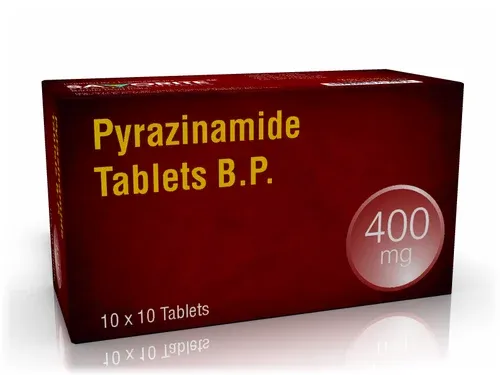INTRODUCTION: Pyrazinamide (PZA) is a relative of nicotinamide. It is stable and slightly soluble in water. It is inactive at neutral pH, but at pH 5.5 it inhibits tubercle bacilli at concentrations of approximately 20 mcg/mL. The drug is taken up by macrophages and exerts its activity against mycobacteria residing within the acidic environment of lysosomes.
MECHANISM OF ACTION: Pyrazinamide is converted to pyrazinoic acid, the active form of the drug by mycobacterial pyrazinamidase. The specific drug target is unknown, but pyrazinoic acid disrupts mycobacterial cell membrane metabolism and transport functions.
RESISTANCE TO THE DRUG: Resistance may be due to impaired uptake of pyrazinamide or mutations in pncA that impair conversion of pyrazinamide to its active form.
PHARMACOKINETICS: Serum concentrations of 30–50 mcg/mL at 1–2 hours after oral administration are achieved with dosages of 25 mg/kg/d. Pyrazinamide is well absorbed from the gastrointestinal tract and widely distributed in body tissues, including inflamed meninges. The half-life is 8–11 hours. The parent compound is metabolized by the liver, but metabolites are renally cleared; therefore, pyrazinamide should be administered at 25–35 mg/kg three times weekly (not daily) in hemodialysis patients and those in whom the creatinine clearance is less than 30 mL/min. In patients with normal renal function, a dose of 40–50 mg/kg is used for thrice weekly or twice-weekly treatment regimens.
CLINICAL USES: Pyrazinamide is an important front-line drug used in conjunction with isoniazid and rifampin in short-course of 6-month regimens as a “sterilizing” agent active against residual intracellular organisms that may cause relapse. Tubercle bacilli develop resistance to pyrazinamide fairly readily, but there is no cross-resistance with isoniazid or other antimycobacterial drugs.
ADVERSE REACTIONS: Major adverse effects of pyrazinamide include hepatotoxicity (in 1–5% of patients), nausea, vomiting, drug fever, and hyperuricemia. The latter occurs uniformly and is not a reason to halt therapy. Hyperuricemia may provoke acute gouty arthritis.
RELATED;
1. TUBERCULOSIS
2. ISONIAZID
3. ETHAMBUTOL
4. RIFAMPIN
5. GOUT











No comments:
Post a Comment